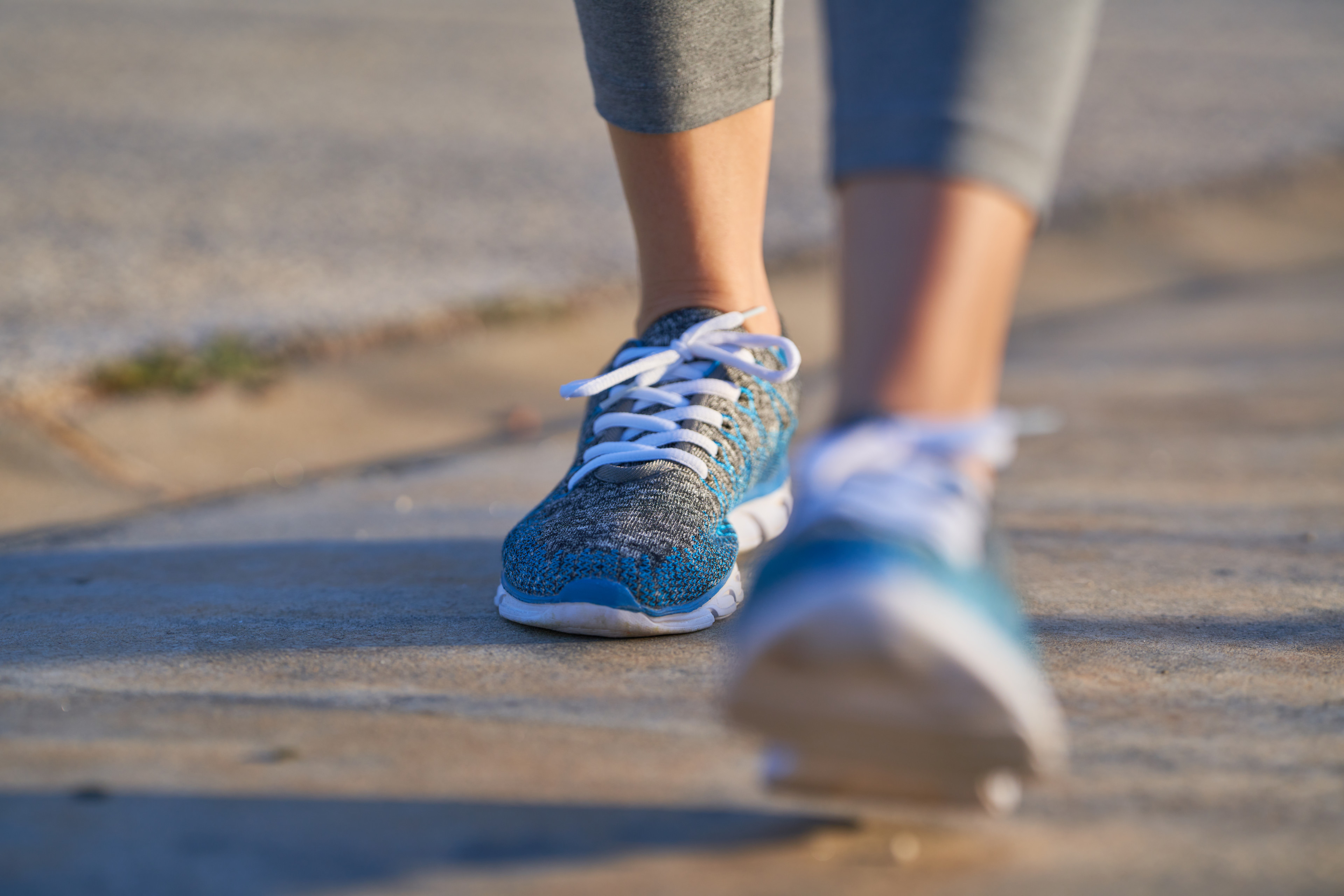
Jorge Alcazar Narvaez/Getty Images
Does Walking Build Muscle? A Peloton Instructor Explains
Matty Maggiacomo dives into how walking can fit into your strength-building routine.
By Hillary Hoffower•
Does Walking Build Muscle?
Key Muscles You Engage and Strengthen While Walking
Which Walking Workouts Should You Do to Build Muscle?
The Takeaway
If you’re trying to build muscle, you’ve probably been busy hitting the weight room and eating protein-packed meals. But have you thought about adding walking to the mix? Although this low-impact exercise is mostly known for its cardiovascular benefits, the right walking routine can enhance muscle engagement and strengthen your legs.
Of course, walking’s impact on your body depends on numerous factors, like your existing activity level and the intensity of your walks. However, it can be an excellent supplement to strength training exercises if you’re looking to maximize muscle gains. Here’s what you need to know.
Does Walking Build Muscle?
Since walking is a low-impact form of movement, it likely won’t give you the larger muscles you’d get from lifting heavy weights at the gym, for example. But upping the intensity, pace, frequency, and resistance of your walks can help stimulate muscle growth and increase lean muscle mass.
“Walking primarily improves cardiovascular health and endurance, but it can also contribute to muscle tone, especially in the legs and glutes, due to the repetitive motion and resistance against gravity,” Peloton instructor Matty Maggiacomo says.
Although walking won’t drastically increase the size of your muscles on its own, research has proven its many other health benefits, such as boosting your mood, lowering your blood pressure, and reducing your risk for chronic disease.
How Can Walking Build Muscle?
Your fitness level may determine how effective walking is for building muscle. For example, walking stimulates more muscle growth in people who are inactive or lead a sedentary lifestyle than it does in those who already work out regularly. A person who’s already active would need to level up their walking game—adding weights, going faster, etc.—to maximize the muscle-building benefits.
Matty is a fan of incorporating inclines, such as hills or stairs; adding resistance, like ankle weights or a weighted vest; or mixing in intervals of faster walking or jogging. These adjustments all increase the intensity, as does trading smooth, flat terrain for an uneven surface, like a nature trail.
Key Muscles You Engage and Strengthen While Walking
Walking primarily targets your lower body, but it also engages some upper body muscles, like your arms and shoulders, according to physical therapist Lex Gonzales. Below he breaks down the key muscles that you work while walking.
Quads: Located in the front of your thighs, your quads extend your knees and stabilize your leg as you step forward.
Hamstrings: Located in the back of your thighs, your hamstrings help bend your knees and extend your hips, pulling your legs backward as you walk.
Calves: Your calves, which are in the back of your lower legs, propel you forward and help you lift your heels as you walk.
Gluteal Muscles: Your glutes are crucial for stabilizing your pelvis and moving your leg back as you stride.
Hip Flexors: These muscles lift your thighs as you step forward.
Core Muscles (aka your abdominals and lower back): Your core plays a vital role in maintaining your posture and balance while walking.
Different types of walking can influence which muscles you work and how intensely they engage, Gonzales explains. For example, brisk walking and downhill walking rely heavily on your quads to move more quickly or control your descent, he says. Walking uphill can challenge the muscles in the back of your legs, such as your hamstrings, more so than walking on a flat surface.
Power walking, which involves more exaggerated arm swings, and Nordic walking, which incorporates poles, can transform walking into a full body exercise by working your upper body muscles, like your shoulders and arms, he says. And hiking on uneven terrain engages your core, leg muscles, and the smaller stabilizing muscles around your ankles and feet as you try to maintain balance.
“By mixing different types of walking into your routine, you can ensure a well-rounded fitness regimen that enhances muscle tone, strength, and endurance across your body,” Gonzales says.
Try a Walking Class On the Peloton App
See all classesWhich Walking Workouts Should You Do to Build Muscle?
If some walking workouts exert your muscles more than others, then which ones are the most effective? Gonzales suggests focusing on the following five.
1. Incline Walking
Walking at an incline, whether you do it on a hill or a treadmill, can significantly increase the load on your lower body muscles, particularly your glutes, hamstrings, and calves, Gonzales says. It forces these muscles to work harder to overcome gravity, he adds.
If you incline walk on a treadmill, warm up first, start at an incline of zero percent, and then gradually increase the intensity. If you’re a beginner, walk at a one to four percent incline for shorter durations, such as 10-15 minutes. As you develop more muscle strength, increase to an incline of 10 percent or higher to more effectively target your glutes, quads, and hamstrings.
2. Nordic Walking
Nordic walking incorporates poles that allow you to generate more power with each stride. Using these poles “adds an upper body element to the traditional walking workout, engaging your arms, shoulders, and back in addition to your legs and core,” Gonzales says. “This can help build upper body strength while also increasing the intensity of the workout, leading to greater muscle engagement and growth.”
3. Speed Walking
According to Gonzales, varying your walking pace challenges your muscles in different ways and improves your strength and endurance, so try adding intervals of faster strides. He suggests alternating between one minute of brisk walking and one minute of slower recovery walking.
4. Stair Walking
Repeatedly walking up stairs or running stadium steps targets your quads, hamstrings, and glutes, and Gonzales says it can be particularly effective for building lower body strength.
5. Weighted Walking
Weights place more demand on your muscles—especially the ones in your core and lower body—to help build strength and endurance, Gonzales explains. Just make sure the weight is manageable and evenly distributed to avoid injury.
Here are three different ways you can incorporate weights into your walking routine.
Add one to three pound ankle weights to build leg strength
Wear one to three pound hand weights to get your upper body involved
Add a weighted vest or go rucking, which involves carrying weights or a sandbag in a backpack, for more of a challenge
How Often Do You Need to Walk to Build Muscle?
There's no magic number, but Matty says you should aim for at least 30 minutes of moderate to vigorous walking three to five times per week to effectively build muscle. “Allow for rest days to prevent overtraining,” he says. So even though you’ve probably heard that you need to take 10,000 steps a day to reap the health benefits of walking, the reality is a lot more nuanced (especially if you’re engaging in more intense walking workouts like the ones we listed above).
To maximize muscle building, pair your walks with other workouts. Cross training can target different muscle groups and prevent you from plateauing, Matty says. He suggests adding in strength training exercises like lunges, squats, or resistance band workouts for a well-rounded routine.
A small 2018 study published in the National Library of Medicine examined the effects of a 10-week walking program on inactive adults who were 65 and older, dividing the 64 participants into two groups: one that did a walking-only plan and one that combined walking with resistance training. Although both groups showed improved muscle size, those who did the combined program showed more improvement. Research shows that even a low-intensity strength and walking program can help people maintain muscle mass as they age.
And if you prefer high-intensity cardio, you can seamlessly do those workouts in conjunction with walking—you don’t have to choose one or the other. According to Matty, activities like cycling or swimming can complement walking for overall fitness and muscle development.
Does Your Walking Speed Matter?
Maintaining a steady and comfortable walking speed can help build endurance, but it shouldn’t be your sole focus if your priority is building muscle.
“The intensity of your walk matters more than speed alone,” Matty says. “Focus on maintaining good form and increasing the challenge gradually, whether that’s by increasing speed, adding resistance, or tackling steeper inclines.”
The Takeaway
Many factors are at play when it comes to how helpful walking is for muscle growth: your fitness level, your diet, and the intensity of your walks, to name a few. And although walking alone probably isn’t going to noticeably increase the size of your muscles, it can supplement other workouts, like resistance training and weight lifting, in your strength-building routine. To get started, we recommend trying a walk or hike on the Peloton App.
This content is for informational and educational purposes only and does not constitute individualized advice. It is not intended to replace professional medical evaluation, diagnosis, or treatment. Seek the advice of your physician for questions you may have regarding your health or a medical condition. If you are having a medical emergency, call your physician or 911 immediately.
Level up your cardio workouts
Enter your email to get articles, instructor tips, and updates from Peloton sent to your inbox.
By providing your email address, you agree to receive marketing communications from Peloton.
For more about how we use your information, see our Privacy Policy.











